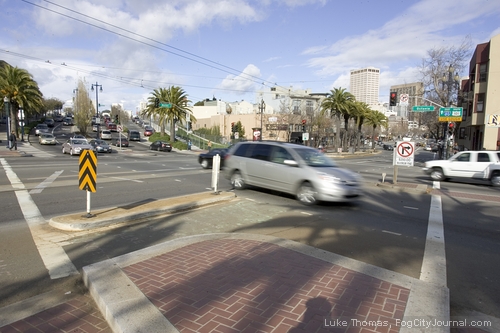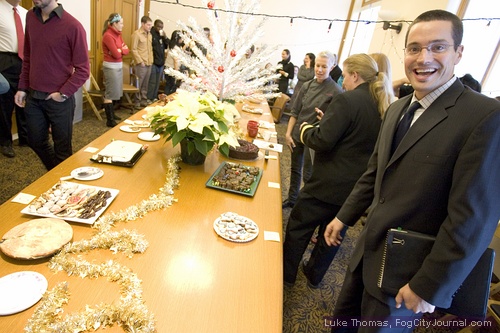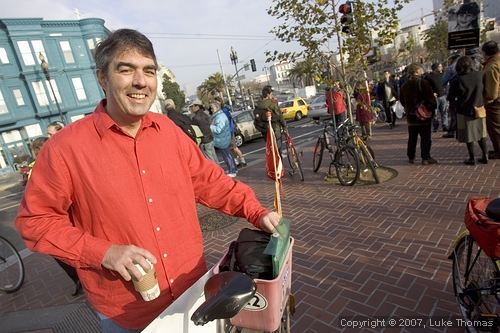
Despite efforts to improve safety for cyclists and pedestrians
and prevent motorists from making an illegal right turn
onto the southbound entrance to the 101 Freeway,
the intersection remains dangerous and a threat to public safety.
Photos by Luke Thomas
By Luke Thomas
January 25, 2009
Despite well-intended efforts by the city and bicycle advocacy groups to prevent collisions between cyclists and motorists at the intersection of Market and Octavia streets, the intersection remains a potential death trap for those cyclists who assume motorists will obey the law and not be tempted to make the illegal right turn onto the southbound entrance of the 101 Freeway.
Call it Murphy’s Law – anything that can go wrong, will go wrong. Add a false sense of security that comes with a bike lane, a turn barrier, a traffic signal, and clear signage indicating a right turn onto the freeway is prohibited, illegal, and subject to $250 fines – and you have a recipe, quite literally, for disaster.
The temptation is just too great for some scofflaw motorists who will make the illegal turn as fast as possible to avoid detection, thereby increasing the threat to life and limb of unwitting cyclists who have a green light, the right of way, and too much downhill speed to prevent or avoid a collision.
Case in point: Director of Climate Protection Initiatives Wade Crowfoot said a false sense of security was the “greatest contributing factor” that resulted in a collision he had with a motorist who made the illegal right turn while he was cycling eastbound through the intersection.

Director of Climate Protection Initiatives Wade Crowfoot
The accident sent Crowfoot to the emergency room where he received 14 stitches to close a wound on his chin.
The intersection continues to be the city’s most dangerous for cyclists. According to the San Francisco Municipal Transportation Agency (SFMTA), “It was the City’s highest bicycle collision intersection for 2007, with many of these collisions related to illegal right turns from eastbound Market Street to the freeway on-ramp.”
Due to a court injunction, however, the SFMTA is limited in what it can do to implement any additional safety improvements at the intersection until an environmental impact report (EIR) on the San Francisco Bicycle Plan is approved. That approval is expected later this year.
Until the city and the SFMTA are able to implement a solution that makes it physically impossible for motorists to make an illegal right turn onto the freeway, cyclists should approach the intersection defensively, with extreme caution and at reduced and controllable speeds, mentally and physically prepared to make an emergency stop as soon as there’s any indication that a motorist is about to make an illegal right turn.
Cyclists should also avoid being in the blind spots of motorists at all times, areas of the road that motorists cannot see while looking forward or through either the rear-view or side mirrors.
San Francisco Bicycle Coalition (SFBC) Program Director Andy Thornley said he agreed with a defensively minded strategy to maximize cyclist safety, a strategy he said is incorporated in the SFBC’s training and safety courses.
During a recent interview with Fog City Journal, Thornley said: “Does the bike lane at the Market and Octavia inbound – does that express a false sense of security? Yes, just the same way that a green light extends, probably, a false sense of security. I would advise, and I advise your readers, that at every intersection, don’t trust the green light, don’t assume that that’s adequate, assume that everyone is going to break the law, and ride defensively.”

San Francisco Bicycle Coalition Program Director Andy Thornley
Thornley said the SFBC will be beefing up its safety outreach to its 10,000 strong membership and urged the SFMTA to step up its public outreach efforts as well.
More Info
San Francisco Bicycle Coalition



 The Hunger Site
The Hunger Site
January 29, 2009 at 5:43 pm
I recently purchased directional turn signals for my bicycle and the 1st day I used them they saved my life at an intersection where a truck was making a right turn.
It’s a no brainer. I purchased mine at http://www.safetybikesignals.com
Why aren’t morepeople using them.
It should be a mandatory law like helmets.
January 29, 2009 at 11:38 am
“Rob, cyclists continuing on the Panhandle bike path, the city’s ONLY class 1 bike facility or continuing east on the Market Street bike lane at Octavia are not breaking the law yet motorists who are breaking the law are perpetrating battery on cyclists.”
Stand near the Fell/Masonic intersection on a Saturday afternoon and you will see cyclists rush to beat the traffic light just like motorists. Just because that light is shaped like a bike doesn’t mean many cyclists have suddenly become safe and sane riders.
“It is not that you are that good or your position is that well articulated, rather to the contrary.”
Our successful litigation was based on the simple fact that the city did not environmental review of the 500-page Bicycle Plan project. I don’t know about “good,” but I pride myself on being articulate. Let me know if there’s anything you want explained.
January 28, 2009 at 11:44 pm
The greatest danger to cyclits is booze. I regularly fall off when loaded and find that motorists often stop to pick me up. Can I strongly suggest that cyclists wear a flourescent orange vest when drunk, with LOADED across the back so that car drivers can make the necessary adjustments.
AJ
January 28, 2009 at 10:16 pm
Rob, cyclists continuing on the Panhandle bike path, the city’s ONLY class 1 bike facility or continuing east on the Market Street bike lane at Octavia are not breaking the law yet motorists who are breaking the law are perpetrating battery on cyclists.
Please don’t ask me to explain or rationalize the repeated failure of the City Attorney to prevail in court on this matter. It is not that you are that good or your position is that well articulated, rather to the contrary.
-marc
January 27, 2009 at 10:42 am
City cyclists need to acknowledge the wisdom of cyclist, bike messenger, and author Robert Hurst: “”There is no greater danger to the cyclist than the cyclist’s own incompetence.”
Marc says: “Any San Franciscan knows that the mere presence of traffic control devices in and of itself does not coerce compliance with traffic laws by motorists.” The same can be said of cyclists in SF, who often ride with astonishing recklessness on the streets of the city. Then, when the inevitable accidents happen, they call on the city to make their dangerous transportation “mode” safe!
The fact of the matter is there haven’t been many right-turn accidents at that intersection in the last year, Crowfoot notwithstanding. The city couldn’t show the judge a factual basis for declaring an emergency at that intersection. Nor could the city show that its proposed changes could make it any safer.
Judge Busch allowed the Fell/Masonic intersection to be changed last year, which involved ending the sharing of a green light by motorists and cyclists. Why not try that at this intersection?
January 26, 2009 at 3:06 pm
They should install cameras and send tickets to everyone who makes illegal turns at this intersection, as well as fell/masonic. and the fine should be way more than 250 bucks. A life is worth much more than that. start sending thousand dollar bills to people who can’t follow the law and jeopardize the lives of cyclists. Punish the drivers who are breaking the laws, not the cyclists trying to legally use their lane.
January 26, 2009 at 9:33 am
Motorists still blow through red lights at Masonic and Fell, both on Masonic and turning from Fell onto Masonic at the special signal.
Any San Franciscan knows that the mere presence of traffic control devices in and of itself does not coerce compliance with traffic laws by motorists.
Design of intersections is likewise critical. The history of the freeway touchdown at Market/Octavia is a lesson in feel good planning and design. There are probably no better academic design answers than have been tried heretofore, as it appears that the MTA is iterating around the “best” answer, off by the margin of error each time.
Any effort to innovate in traffic control devices is stymied by an onerous state process for indemnifying the City from legal exposure. This is why Oregon is light years ahead of California on bicycle facilities and why all the MTA can do right now to create colored bike lanes is to test the paint in their garage. As if we don’t have reams of data telling us how paint performs under motor vehicle tires and know that loads of an order of magnitude less that one sees with bicycles will not significantly impact paint.
Also, 5 years ago, when Hayes Valley got gentrified and all the North Mission got was a new freeway, added heights and condo towers, CalTrans stated that the useful lifespan of the upper deck of the Central Freeway was 10 years. Now that we are more than half way through that lifespan, it is time to plan to bring the freeway down at Bryant, continue the boulevard to Market, and to begin to rationalize the Market and Octavia intersection without the red meat of a freeway entrance ramp right there.
Part of the solution is going to have to be enforcement by the cops of the Vehicle Code congruent with San Francisco’s stated policy values which privilege transit, cyclists and peds over autos.
The commuter police force cannot be counted upon to bring San Francisco values to bear in doing their job, as each cop essentially has free rein to enforce or not enforce whichever laws they feel like at any given time. There is little or no political control by policymakers over the police departmnet. When political control is exercised, the SFPD resists until forced otherwise. It requires the political use of force to coerce the SFPD to do their jobs on our terms.
We need the equivalent of foot patrols for safe streets because the approach of the MTA and SFPD is to coddle lawbreakers by forcing cyclists who ride legally to accommodate motorist illegality.
Put enough motorists who hit cyclists at that intersection in prison for battery or attempted murder and they might get the message that the first rule of driving is keep control of your damn vehicle.
-marc
January 25, 2009 at 4:55 pm
out at masonic and fell they put in a special light for cyclists riding in the panhandle. that should be done at octavia/market to ensure the illegal turns and injuries stop.
January 25, 2009 at 4:28 pm
I guess it would be to much for the city to come up with a pop up barrier triggered by the signal light and lowered when it is the cross traffics turn to go.
January 25, 2009 at 1:48 pm
Jeeez,
Worldwide, cities put permanent traffic cops at intersections like this one. Of course, they also put police kiosks on corners of dangerous crime centers like 24th and 26th and Mission. Could SF do that?
Well, believe it or not, we used to have kiosks on those corners and in other dangerous areas and real traffic cops standing out in the rain. The POA negotiated those little crime-stopping amenities out under, first Willie Brown, then Newsom.
However, we have some of the best protected donut and coffee shops in the world.
h.